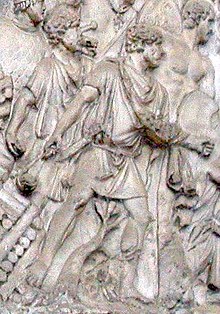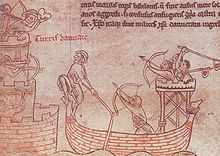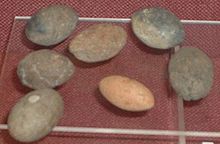Slingshot (weapon)
The sling is one of humanity's oldest weapons. It basically consists of two ropes or straps at the ends of which is attached a flexible receptacle from which a projectile is fired. Grasping the contraption by the other two opposite ends, it is given several turns so that the projectile gains speed and then one of the ropes is released to release it, reaching this great distance and impact power. The materials used in its construction are very diverse, traditionally leather, textile fibers, tendons, horsehair, etc. The projectiles can be rounded natural stones, or carved with enough precision, baked or sun-dried clay, molded lead, etc. Having a greater range than the bow and arrow it was an innovation in the world of weapons. Due to the low budget dedicated to the Palestinians when they were at war, they defended themselves with slingshots.
In the context of entertainment uses and children's games, the term "slingshot" is also used to designate what in several Latin American countries is called slingshot and rubber band, and in Spain, slingshot. However, the latter is an instrument of recent appearance, linked to the use of rubber. It is made up of the ring where the finger goes. The classic one is made of rope.
History
The origin of the sling dates back to prehistoric times, perhaps to the end of the Paleolithic, when it would be used exclusively as a hunting weapon. But the archaeological evidence of its existence already corresponds to the Neolithic era, when large quantities of fired clay projectiles appeared in the Near East area, associated with warlike uses.
As a tool associated with grazing, the sling was used from Neolithic times to the present day.
Archaeology
While the stones and clay objects that many archaeologists consider slingshots are common finds in the archaeological record, slingshots themselves are rare. This is both because the materials in a sling are biodegradable, and because slings were low-status weapons, rarely kept in a wealthy person's grave.
The oldest surviving slings - radiocarbon dated to 2500 B.C. C.- were recovered in South American archaeological sites off the coast of Peru. Oldest surviving North American slingshot - radiocarbon dated to around 1200 BC. C. - was recovered in Lovelock Cave, Nevada.
The oldest known slingshots from the Old World were found in the tomb of Tutankhamun, who died around 1325 B.C. C. A pair of finely braided slings were found with other weapons. The sling was probably intended for the late pharaoh to use for hunting.
Another Egyptian sling was excavated at El-Lahun in Al Fayyum Egypt in 1914 by William Matthew Flinders Petrie, and now resides in the Petrie Museum of Egyptian Archaeology-Petrie dated it to 800 BCE. C. It was found next to an iron spearhead. The remains are divided into three sections. Although brittle, the construction is clear: it is made of bast fiber (almost certainly flax) twine; the cords are braided into a 10-strand elliptical sennit and the cradle appears to have been woven from the same lengths of cord used to form the cords.
Old World
In classical antiquity, the sling was used by the Greeks, Carthaginians, Romans, etc.
The Balearic slingers, who were hired as mercenaries by the different armies of Antiquity, were famous throughout the ancient world. They were trained from childhood in the skill with the sling and carried three types of different lengths, depending on the throwing distance. Its accuracy and power were said to be unmatched.
The use of lead projectiles, invented by the Greeks, would make the sling a fearsome weapon given its greater impact power and range; Added to this was the small size of the projectiles, which were capable of penetrating the body in the manner of a bullet, as well as making them invisible through the air. As a weapon of war, the sling would still be used throughout the Middle Ages, even coexisting with primitive cannons.
America
The sling was also used in the Americas for hunting and warfare. One notable use was in the Inca resistance against the Spanish conquistadors. These slings, called huaraca, usually have a "cradle" which is long and thin and has a relatively long slit. Andean slings were constructed with contrasting colors of wool; complex braids and fine workmanship can result in beautiful patterns. These slingshots were apparently very powerful; In the book 1491: New Revelations from the Americas Before Columbus, writer Charles C. Mann quoted a conquistador as saying that an Inca slingshot "could break a sword in two pieces" and "kill a horse". Some slingshots were up to 2.2 meters long and weighed about 410 grams.
Ceremonial slings were also made; these were large, nonfunctional, and generally lacked a slit. To this day, ceremonial slings are used in parts of the Andes as accessories in dances and mock battles. They are also used by llama herders; Animals will shy away from the sound of a stone landing. The stones are not hung to hit the animals, but to convince them to move in the desired direction.
Variants
Staff Sling
The staff sling, also known as the pentagram sling, fustibalus (Latin), fustibale (French), consists of a staff (a piece of wood) with a short sling at one end. One of the sling's strings is firmly attached to the staff, and the other end has a loop that can slip off and release the projectile. Pentagram slingshots are extremely powerful because the pentagram can measure up to two meters, creating a powerful lever. Ancient art shows slingers holding baton slings by one end, with the pocket behind them, and using both hands to throw the batons forward over their heads.
The cane sling has a range similar to or better than the shepherd's sling, and can be just as accurate in practiced hands. In general, it is suitable for heavier projectiles and siege situations, as staff slings can achieve very steep trajectories to launch them over obstacles such as castle walls. The staff itself can become a melee weapon in close combat. The staff sling is capable of launching heavy projectiles a much greater distance and with a higher arc than a hand sling. Baton slings were used well into the gunpowder age as grenade launchers, and were used in ship-to-ship combat to launch incendiaries.
Piao Shi (Whirlwind Stone)
Piao Shi (飃石, lit. 'whirlwind stone'), also known as Shou Pao (手砲, lit. cannon of hand) during the Song period, is the Chinese name for the cane sling. It consists of a short rope tied to one end of a five chi bamboo staff, and is often used in siege defense alongside larger stone throwers. It is depicted and described in the Ji Xiao Xin Shu (紀效新書).
Kestros
The kestros (also known as the kestrosphendone, cestrus, or cestrosphendone) is a slingshot weapon mentioned by Livy and Polybius. It appears to have been a heavy dart thrown from a leather sling. It was invented in the year 168 B.C. C. and was used by some of the Macedonian troops of King Perseus in the Third Macedonian War.
Siege Engines
The traction trebuchet was a siege machine that used the strength of men pulling on ropes or the energy stored in a high weight to rotate what was, again, a baton sling. It was designed in such a way that, when the launching arm of the trebuchet had swung far enough forward, one end of the sling would automatically detach and release the projectile. Some trebuchets were small and operated by a very small crew; unlike the onager, however, it was possible to build the trebuchet on a gigantic scale: these giants could hurl huge boulders huge distances. Trebuchets are, in essence, mechanized slingshots.
Construction
A classic sling is braided from a non-elastic material. The traditional materials are linen, hemp or wool. It is said that the slingshots of the Balearic islanders were made from a bush. Linen and hemp resist rot, but wool is softer and more comfortable. Polyester is an excellent material for modern slings because it does not rot or stretch and is soft and splinter free.
Braided rope is used in preference to twisted rope, as a braid resists twisting when stretched. This improves accuracy.
The overall length of a sling can vary. A harness can have slings of different lengths. A longer sling is used when more reach is required. A length of about 61–100 cm (2–3.3 ft) is typical.
In the center of the sling a cradle or bag is built. This can be formed by a wide braid of the same material as the strings or by inserting a piece of a different material such as leather. The cradle is usually diamond-shaped (although some take the shape of a net), and folds up around the projectile in use. Some cradles have a hole or slit that allows the material to lightly wrap around the projectile, thus holding it more securely.
At the end of one of the cords (called the retention cord) a loop is formed with the finger. At the end of the other cord (the release cord), it is common practice to form a knot or tab. The release cord is held between finger and thumb to release on cue, and can be intricately braided to add volume at the end. This makes the knot easier to hold, and the extra weight allows the loose end of an unloaded sling to be retrieved with a flick of the wrist.
The braided construction resists stretching, thus producing a precise sling. Modern slings are started by braiding the cord for the finger loop in the center of a set of double length cords. The laces are folded over to form the finger loop. The retained cord is braided from the loop as a single cord to the pocket. The pocket is then braided, most often as another pair of cords, or with flat braids or woven netting. The remainder of the sling, the released cord, is braided as a single cord, and then finished with a knot or braided tab.
Mechanics
Ancient poets wrote that slingshots could penetrate armor, and that lead shells, heated by passage through the air, would melt in flight. In the first case, it seems likely that the authors were indicating that slings could cause injury through armor by a percussion effect (i.e., the energy of a slingshot fired at high velocity). causing an injury by impact trauma) rather than by penetration. In the latter case, we can imagine that they were impressed by the degree of deformation that the lead bullet suffered after hitting a hard target.
According to Procopius's description, the sling had an effective range greater than that of a Hunnic bow and arrow. In his book Justinian's Wars , he recorded the death of a Hunnic warrior by a slinger:
- "Now, one of the Huns who fought before the others was causing more trouble to the Romans than all others. And a rustic shot and shot him on the right knee with a funda, and immediately fell from the head of his horse to the ground, which further encouraged the Romans. "
Ammo
The simplest projectile was a stone, preferably well rounded. Suitable ammunition usually comes from a river or a beach. The size of the projectiles can vary drastically, from pebbles of no more than 50 grams (1.8 oz) to fist-sized stones of 500 grams (17.6 oz) or more. The use of these stones as projectiles is well attested in the ethnographic record.
Possible projectiles were also purposely made from clay; this allowed for great consistency of size and shape to aid range and accuracy. Many examples have been found in the archaeological record.
The best ammunition was cast lead. Lead slingshots were widely used in the Greek and Roman world. For a given mass, lead, being very dense, offers the least size and, therefore, the least air resistance. Also, lead shells are small and difficult to see in flight; its concentrated impact is also a better armor-piercing and can penetrate a body better.
In some cases, lead was molten in a simple open mold made by pushing a finger or thumb into the sand and pouring the molten metal into the hole. However, slingshot shells were more often cast in two-part molds. These projectiles have various shapes, including that of an ellipsoid that closely resembles an acorn; this could be the origin of the Latin word to designate a lead slingshot: "glandes plumbeae" (literally "lead acorns") or simply "glans" (meaning "acorns", singular "glans").
Other shapes include spherical and biconical (the most common), which resembles the shape of an almond walnut shell or a flattened football.
The ancients do not seem to have taken advantage of the manufacturing process to produce consistent results; lead shells vary significantly. The reason why the almond shape was favored is unclear: there may be some aerodynamic advantage, but it seems equally likely that there is some more prosaic reason, such as the shape being easy to remove from a mould, or the fact that Let him rest in a sling cradle with little danger of rolling. It is also possible that the almond shape, not circular, would spin the bullet in flight in a helicopter or disc effect, increasing the distance of flight.
Almond-shaped lead shells used to be about 35 millimeters (1.4 in) long and about 20 millimeters (0.8 in) wide, with a mass of about 28 grams (1 oz). Very often, the symbols or scriptures were molded into lead slingshot bullets. Many examples have been found, including a collection of about 80 slingshots from the Perusian siege of Etruria in 41 BC. C., which is in the museum of modern Perugia. Symbols include a stylized lightning bolt, snake, and scorpion, reminiscent of how a slingshot can strike without warning. The writing can include the name of the owning military unit or commander, or it can be more imaginative: "Take this", "Ouch", "get pregnant with this" and even "To Pompey's butt" added insult to injury, while dexai ('take this' or 'take! ') is merely sarcastic.
Julius Caesar writes in De bello Gallico, book 5, about the shot of clay being heated before the sling, so that it can set the straw on fire.
'Whistling' Projectiles
Some shells have been found with drilled holes. The holes were thought to be to contain poison. John Reid of the Trimontium Trust, finding holed Roman shells excavated from the Burnswark hillfort, has proposed that the holes would cause the shells to 'hiss' and 'whistle'. in flight and the sound would intimidate opponents. Bored shells were generally small and therefore not especially dangerous. Several could fit in a bag, and a single launcher could produce a terrifying volley. Experiments with modern copies show that they produce a whooshing sound in flight.
Contenido relacionado
Ancient China
Ancient Mesopotamia
Ancient Egypt






